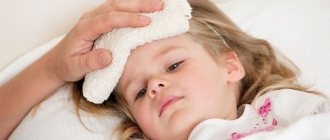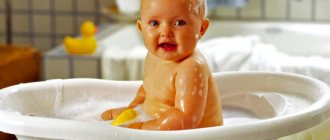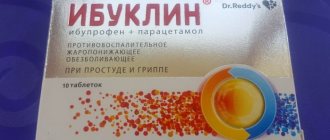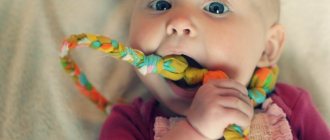Child's temperature
The younger the child, the more dangerous the temperature is for him. It cannot be determined with a kiss on the forehead; in infants it is better to measure it with a pacifier thermometer.
You must follow the following rules:
- measure at least 3 times during the day;
- measure not when the child is active, when he is crying or playing, taking a bath or wrapped up warmly, but in a calm state, lying down, at a normal temperature in the room.
When measuring temperature orally, it is better to do this on an empty stomach or an hour after eating.
Few adults know that a child’s normal temperature is not necessarily 36.6°C. In infants under one year of age, it is normally slightly higher than in older children. The normal axillary temperature for a child under 1 year of age is considered to be less than +37.4°C, and for a child over 12 months – less than +37°C.
It is usually recommended to bring down febrile temperature indicators, i.e. more than 38°C if the child does not tolerate it well.
In some cases, medications are also needed for low-grade symptoms:
- less than 2 months old;
- if there are cardiac pathologies;
- with convulsive readiness;
- when overheated.
Attention: temperature exception!
There is one exception among bacterial infections, which in children can actually occur without any other symptoms other than high fever. These are urinary tract infections.
Adults with the same condition experience a frequent urge to urinate and sharp pain in the lower back, but children, fortunately, do not feel anything like that. Therefore, in order not to miss the potential development of a urinary tract infection in the absence of symptoms, a child with a high fever is usually prescribed a clinical urine test.
So, if the baby has a fever and there are no other symptoms besides it, then most likely he is either overheated or has been attacked by a viral infection. In rare cases, a child may have a urinary tract infection - these concerns can easily be allayed with a urine test.
How can you determine before the doctor arrives and before testing whether your child has a viral or bacterial infection? Let's make a reservation right away - the sign we are talking about cannot in any case be called a 100% accurate diagnostic method, but often it helps to correctly determine the nature of the infection.
As a rule, with a viral disease, the child’s skin retains a bright, pink tint. Whereas with a bacterial infection, the skin becomes “deadly” pale.
Simply put, if the baby’s temperature has “flyed up” to 38.5° C, but at the same time his ears and cheeks are scarlet, then you don’t have to worry, this is a viral infection that can be “suppressed” with home-made, non-drug methods. But if a child has a high temperature and at the same time he has become as pale as snow, call the doctors for help, you need them now and urgently!
Doctor Komarovsky's opinion
Many parents believe that fever is not a serious thing, but you need to give your baby a pill and everything will go away. This is where many mistakes lie: they wrap up the child, warm the room, do not allow the baby to move, and try to feed him to preserve strength in the fight against the disease. All actions are absolutely wrong. You need to forget about food until the child himself wants it.
You should provide your baby with several things:
- give enough fluids;
- do not overheat or overcool the child;
- the room temperature should not be higher than 18-20 degrees;
- the air must be clean and humidified.
The temperature should normalize on the 4th day; on the 7th day it should not be there at all.
Rules for the “treatment” of high temperature for viral infections
If a child has no other symptoms due to a viral infection (such as cough, runny nose and nasal congestion, lethargy and apathy, and others), then in just a couple of days the body temperature should normalize on its own with the following actions:
- 1 The baby should not be loaded with food (if he doesn’t ask to eat, then don’t feed him at all!);
- 2 The child must be “put on” a regime of drinking plenty of fluids (any liquid is suitable for these purposes: from plain water to sweet fruit drinks and compotes);
- 3 In the room where the child lives, a cool and humid climate should be established (namely: reduce the heating to 19-20 ° C maximum, and, on the contrary, increase the air humidity to 60-70%).
If parents correctly followed all of the above instructions, the results will be quite definite:
- After two days, the child’s well-being should improve and a gradual decrease in temperature should begin;
- On the fifth day, normal temperature should be established.
If on the 3rd day a child with a fever has not experienced any improvement in well-being, or on the 5th day the temperature has not returned to normal, you must consult a doctor and also take blood and urine tests.
High temperature in a child: Komarovsky
An increase in body temperature is typical not only with ARVI, but also with any childhood infection. At the same time, the body produces substances that protect the body from pathogens. For example, many people know this substance - it is the protein interferon, which has antiviral activity. Its amount has a direct relationship with body temperature, that is, the higher the temperature, the more interferon. This is why many people notice an increase in temperature at the beginning of interferon treatment.
Since interferon increases to a maximum on days 2-3 after the temperature rises, most ARVIs end safely on the third day of illness.
Another option is “very smart” parents (they quickly “brought down the temperature” and are happy) or a weakened immune system in a child who cannot begin the fight against pathogens with a rise in temperature. Here there will be little interferon and it will not be possible to cure ARVI in 3 days. Antibodies will fight the viruses and the duration of the illness will extend to 7 days. This is also an answer to the popular wisdom that “unloved” children are sick for 3 days, and “favorite” children are sick for a week.
The main thing for a child with a fever is to do everything to ensure that the body has the opportunity to lose heat.
Two mandatory actions: drink plenty of fluids so that you have something to sweat, cool air in the room (optimally 18 -20 degrees). If these conditions are met, there is a high probability that the body will cope with the temperature itself.
Tea with raspberries dramatically increases the formation of sweat. It is many times more effective than drugs. But it should not be given to children under one year of age.
If the baby is capricious and chooses food, then it is better to drink anything (mineral water, herbal infusions, tea, viburnum, rose hips, currants, etc.) than not drink at all.
Any drink will be absorbed into the blood only when its temperature is equal to the temperature of the stomach: given cold, it will not be absorbed until it warms up; warm - until it cools down.
What not to do
It is believed that you can reduce the temperature by offering your child a hot drink. This is a fundamentally wrong opinion, since hot liquid is not absorbed by the stomach, and the same can be said about cold drinks. The best solution is a liquid whose temperature is as close as possible to body temperature.
You cannot cool your baby outside. This leads to the fact that the blood vessels narrow, the skin cools, and the internal organs heat up. Heat transfer decreases, and the little patient’s condition becomes worse. Using ice and cold water is extremely dangerous for the health and life of a child.
The greatest harm to a baby's health comes from rubbing with vodka and acetic acid. Harmful substances enter the baby’s blood through the skin, further aggravating his condition. According to Komarovsky, poisoning with alcohol or vinegar due to illness can even lead to death. You should also not do cold enemas, ice compresses, and the like. Such measures can only be taken if the child has been given medications that eliminate vasospasm.
Post published: 09/02/2016
0
Reducing the temperature
Of the antipyretic drugs, only 2 drugs are used for children: Paracetamol (syn. Dofalgan, Panadol, Calpol, Mexalen, Dolomol, Efferalgan, Tylenol) and Ibuprofen. Other drugs cannot be given. The higher the temperature, the thinner the medicine should be.
It is useless to use suppositories - at readings above 38.5°C it will not be absorbed.
Suppositories should be replaced with syrups or solutions - they are absorbed immediately. The tablet will also not help; it will lie peacefully on the wall of the stomach. The temperature of the medicine should be equal to body temperature, i.e. not lower than 37°C. Before giving, you need to warm the bottle in your hands.
Recommended doses:
- Paracetamol 15 mg per kg of weight, maximum single dose 60 mg/kg. You can only use it 4 times a day, no more often! Interval 4 hours. Paracetamol should not be given for more than 3 days.
- Ibuprofen – 10 mg/kg body weight, maximum 25-30 mg/kg. You can give no more than 3 times a day, i.e. interval 6 hours.
To know how much medicine is needed, parents must calculate it in advance, even before the baby gets sick. Because during the illness of a febrile child, parents will not have the time or thought to give the correct dose. You will do this approximately, which should not be allowed.
You can fight the temperature on your own for the first 3 days. If there is no improvement, you should call a doctor on day 4.
The effect of the medicine is a decrease of half a degree after half an hour, and not to 36.6 ° C.
Self-use of paracetamol or ibuprofen is a temporary measure until a doctor arrives. They do not treat, but only reduce the severity of hyperthermia.
High temperature as the body's reaction to viruses and bacteria
High temperature is a normal reaction of the body, the action of which is aimed at destroying foreign agents in the form of viruses, bacteria and infections.
An elevated thermometer reading is not a reason for parents to panic or become hysterical. This is a signal that right now they should do the right thing, and not try to bring it down by any means by any possible means. The first thing that some parents do, who do not hear or do not want to hear doctors, is to use the rubbing procedure with vinegar or vodka. Doctor Komarovsky is simply shouting: “People! You can’t even imagine how many people paid with their lives for such rubbing!” Therefore, never use vinegar or vodka for rubbing with the purpose that they will help you lower body temperature and alleviate the patient’s condition. This rule applies not only to children, but also to adults.
But let’s return to the main question of our topic - what to do and what measures to take if a child has a high temperature. First of all, let's find out in what cases a high temperature (38.5°C - 39°C) can pose a danger to the condition and even the life of the patient.• Diseases of the nervous system, which can trigger the development of seizures,• Individual intolerance to elevated temperature,• Diseases cardiovascular system,• Body temperature above 39.5°C.
How to bring down a child’s temperature without medication, which is what needs to be done first. An exception may be those 4 points listed above, and a sharp increase in the indicator, which already reaches 40°C and above. In these situations, first of all, it is necessary to call an emergency team. In this case, be sure to tell the doctor the condition and age of the child!
• provide a cool room temperature (18-20°C), • provide plenty of fluids, which can stimulate sweating.
Under these two conditions, the body predominantly copes with temperatures up to 40°C on its own.
According to the doctor, a temperature of 39°C is considered critical and parents should be extremely attentive to the baby’s well-being. Further increase in heat can cause serious harm to the child's body.
But if there are signs of an infectious disease, then how to bring down a child’s temperature of 39? Komarovsky believes that it is possible to help a child both without medications and with their help. However, there are a number of cases when medications are given without delay:
- The child does not tolerate heat well
- Having difficulty breathing
- There is vomiting or diarrhea
- Once the child already had convulsions due to fever
- There are serious diseases of the nervous system, for example, cerebral palsy or epilepsy
- Temperature rose above 39°C
If the baby feels normal - he does not have delirium, inappropriate behavior, or difficulty breathing, then you can wait to take medications. The main thing is to create special conditions that will help the baby cope with the fever. To do this you need:
- Put the child to bed, exclude any physical activity
- Do not force feed your baby. If the child asks to eat, then warm food is given - hot food is completely excluded
- Give your child plenty of water - warm compote with sugar would be an ideal option. For children under one year old, the doctor recommends raisin decoction
- Maintain the temperature in the nursery at 18-20°C
- Fill the room with clean and humid air
- Avoid freezing or overheating your child - pajamas made from natural fabrics and a blanket will help
- Wipe with warm water 34-35°C
Cool air and plenty of fluids are the main allies in the fight against high fever.
Cooling occurs through breathing and sweating. Tea with raspberries, honey or linden blossom is given only after the child drinks more than a liter of regular compote. Otherwise, the baby will have nothing to sweat with and the temperature will rise even more.
Rubbing with cold water is also not beneficial. They provoke vasospasm. The skin cools down, and the internal organs, on the contrary, overheat even more. If the child’s condition worsens, then it is necessary to move on to the next stage - taking medications.
According to Komarovsky, parents can only give their children paracetamol or ibuprofen in the dosages prescribed in the instructions.
At high temperatures, suppositories do not have the desired effect, but liquid products are absorbed quickly. However, there are times when even syrup cannot cope with intense heat due to spasm of the mucous vessels. The only way out is an injection of an antipyretic drug, which will be given by a doctor.
Paracetamol is given at intervals of 4 hours, ibuprofen - 6 hours, but no more than 4 times a day. Medicines are compatible with each other. When paracetamol does not work, you can give your child ibuprofen 40 minutes after paracetamol. If the temperature does not subside within 30-40 minutes after taking antipyretics, you should call a doctor.
Temperature and nothing else.
Temperature 37.5, cough and snot - definitely a viral infection. But the temperature and nothing else is a viral infection, but what kind is not clear. If you have the opportunity to see a doctor, do so. And what will happen next? Most likely, if the mother did not see the symptoms, the doctor will not see either. And when a doctor says the phrase “I don’t see anything,” then in the eyes of our average person he seems like the wrong doctor, a bad one. Well, what kind of doctor is this, who has been trained for so many years and cannot make a diagnosis when there is a fever, and he honestly admitted it. Therefore, the mother will go with the child to another doctor, who will say: “Oh, your throat is a little red.” But I must admit that in 30 years of treating children, I have not seen a neck that is a little red, a little blue, a little green, or a little purple. All the necks are a little red. Advice for mothers: occasionally look into the mouth of your healthy child so that you understand what kind of throat your child should have normally. And when the doctor says a little red, you will say the same as always. And it will be easier for the doctor.
Sources
- https://LechimDetok.ru/infektsii/komarovskij-kak-sbit-temperaturu-39-u-rebenka-7990.html
- https://www.woman.ru/kids/healthy/article/172989/
- https://lechimverno.ru/zdorovyj-rebenok/komarovskij-sajt-oficialnyj-temperatura-u-rebenka.html
- https://www.komarovskiy.net/navigator/temperatura-nav.html
- https://o-krohe.ru/bolezni-rebenka/temperatura/komarovskij/
- https://pakpred.ru/proyavleniya/temperatura/komarovskij.html
- https://lpk.ru/komarovskij-temperatura-bez-simptomov/
- https://po-detski.ru/komarovskij-o-temperature/











